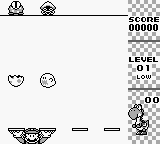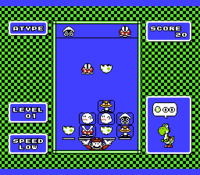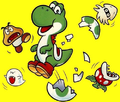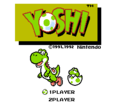Yoshi (game): Difference between revisions
Lord Falafel (talk | contribs) (→Reception: Fixed links) Tag: Mobile edit |
m (Text replacement - "== *Trivia *==" to "==Notes==") |
||
| (97 intermediate revisions by 46 users not shown) | |||
| Line 1: | Line 1: | ||
{{italic title | {{italic title}} | ||
{{ | {{media missing}} | ||
{{game infobox | |||
|image=[[File:Nes Box - Yoshi.png|250px|An image of Yoshi's box]]<br>[[Nintendo Entertainment System|NES]] box art<br>[[File:Y Cover.jpg|250px]]<br>[[Game Boy]] box art | |image=[[File:Nes Box - Yoshi.png|250px|An image of Yoshi's box]]<br>[[Nintendo Entertainment System|NES]] box art<br>[[File:Y Cover.jpg|250px]]<br>[[Game Boy]] box art | ||
|developer=[[Game Freak]] | |developer=[[Game Freak]] | ||
|publisher=[[Nintendo]] | |publisher=[[Nintendo]] | ||
| | |release='''Famicom/NES:'''<br>{{flag list|Japan|December 14, 1991<ref>{{cite|url=www.nintendo.com/jp/famicom/software/fmc-yeg/index.html|title=ヨッシーのたまご <nowiki>| ファミリーコンピュータ | 任天堂</nowiki>|publisher=Nintendo Co., Ltd.|language=ja|accessdate=January 13, 2025}}</ref>|USA|June 1992<ref name=SSBB>''Super Smash Bros. Brawl'' {{iw|smashwiki|Chronicle}}</ref><ref>{{cite|deadlink=y|archive=web.archive.org/web/20080921015524/http://www.nintendo.com/consumer/gameslist/manuals/nes_games.pdf|title=Nintendo ''NES Games'' release chart|format=PDF|publisher=Nintendo.com|accessdate=June 1, 2024}}</ref>|Europe|December 30, 1992<ref>{{cite|url=www.themushroomkingdom.net/games/yoshi-nes|language=en|title=''Yoshi'' (NES)|publisher=The Mushroom Kingdom|accessdate=June 1, 2024}}{{better source}}</ref>}}'''Game Boy:'''<br>{{flag list|Japan|December 14, 1991<ref>{{cite|url=www.nintendo.co.jp/n02/dmg/yoj/index.html|title=ヨッシーのたまご|publisher=Nintendo Co., Ltd.|language=ja|accessdate=January 13, 2025}}</ref>|USA|July 1992<ref name=SSBB/><ref>{{cite|deadlink=y|archive=https://web.archive.org/web/20081003181232/http://www.nintendo.com/consumer/gameslist/manuals/dmg_games.pdf|title=Nintendo ''Game Boy (original) Games'' release chart|format=PDF|publisher=Nintendo.com}}</ref>|Europe|December 17, 1992<ref>{{cite|url=www.themushroomkingdom.net/games/yoshi-gb|title=''Yoshi'' (GB)|publisher=The Mushroom Kingdom|accessdate=June 1, 2024|language=en}}</ref>}}'''Virtual Console (Wii):'''<br>{{flag list|Japan|March 6, 2007|Europe|May 18, 2007<ref>{{cite|url=www.nintendo.com/en-gb/Games/NES/Mario-Yoshi-752891.html|title=''Mario & Yoshi''|publisher=Nintendo of UK|language=en-gb|accessdate=June 1, 2024}}</ref>|Australia|May 18, 2007|USA|July 9, 2007|South Korea|August 12, 2008<ref>{{cite|deadlink=y|archive=web.archive.org/web/20081205120942/http://www.nintendo.co.kr/Wii/wii/vconsol.php|title=Wii|language=ko|publisher=Nintendo of Korea|accessdate=June 1, 2024}}</ref>}}'''Virtual Console (3DS) (Ambassador Program Release):'''<br>{{flag list|Japan|August 31, 2011|USA|September 1, 2011|Europe|September 1, 2011|Australia|September 1, 2011}}'''Virtual Console (3DS) (Full Release):'''<br>{{flag list|Japan|August 22, 2012|USA|February 21, 2013|Europe|May 2, 2013|Australia|May 2, 2013}}'''Virtual Console (Wii U):'''<br>{{flag list|Japan|June 12, 2013|USA|June 12, 2013|Europe|June 13, 2013|Australia|June 13, 2013}}'''Nintendo Entertainment System - Nintendo Switch Online:'''<br>{{flag list|USA|September 18, 2018|Japan|September 19, 2018|Europe|September 19, 2018|Australia|September 19, 2018|HK|April 23, 2019|South Korea|April 23, 2019}} | ||
|genre=Puzzle | |languages={{languages|en_us=y|jp=y}} | ||
|genre=[[Genre#Puzzle|Puzzle]] | |||
|modes=1-2 players in a same system | |modes=1-2 players in a same system | ||
|ratings={{ratings|esrb=E|usk=0|pegi=3|acb=G|cero=A}} | |ratings={{ratings|esrb=E|usk=0|pegi=3|acb=G|cero=A|rars=0+|grac=all}} | ||
|platforms=[[Family Computer | |platforms=[[Family Computer]],<br>[[Nintendo Entertainment System]],<br>[[Game Boy]],<br>[[Virtual Console]] ([[Wii]], [[Nintendo 3DS|3DS]], [[Wii U]]),<br>[[Nintendo Entertainment System - Nintendo Switch Online]] | ||
| | |format={{format|fc=1|nes=1|gb=1|wiidl=1|3dsdl=1|wiiudl=1|switchdl=1}} | ||
|input={{input|nes=1|gb=1|wmsideways=1|classic=1|wiigcn=1|3ds=1|wiiusideways=1|wiiupro=1|wiiuclassic=1|joy-con=1}} | |input={{input|fc=1|nes=1|gb=1|wmsideways=1|classic=1|wiigcn=1|3ds=1|wiiusideways=1|wiiupro=1|wiiuclassic=1|joy-con=1|joy-con-horizontal=1|switchpro=1|switchfc=1|switchnes=1|switchsnes=1}} | ||
|serials='''Famicom/NES:'''<br>{{flag list|Japan|HVC-YM|USA|NES-YM (USA/Europe)}}'''Game Boy:'''<br>{{flag list|Japan|DMG-YOJ|USA|DMG-YO-USA (USA/Europe)}} | |||
}} | }} | ||
'''''Yoshi''''' | '''''Yoshi''''' (known in Japan as '''''Yoshi no Tamago''''' (ヨッシーのたまご, lit. "Yoshi's Egg") and as '''''Mario & Yoshi''''' in other non-American regions) is a [[Genre#Puzzle|puzzle]] game for the [[Family Computer]]/[[Nintendo Entertainment System|NES]] and [[Game Boy]] featuring the [[Yoshi|titular character]]. In this game, the player must stack two of the same ''[[Super Mario (franchise)|Super Mario]]'' enemy on top of one another to clear them. The concept of the game was inspired by ''[[Tetris]]''. | ||
The NES version of this game was later released on the [[Virtual Console]] for [[Wii]], [[Nintendo 3DS]], and [[Wii U]]. It was also made available as one of the 20 NES titles at the [[Nintendo Switch#Nintendo Switch Online|Nintendo Switch Online]] | The NES version of this game was later released on the [[Virtual Console]] for the [[Wii]] in 2007, the [[Nintendo 3DS]] in 2011-2012, and the [[Wii U]] in 2013. It was also made available as one of the 20 NES titles at the [[Nintendo Switch#Nintendo Switch Online|Nintendo Switch Online]]'s service launch in September 2018. | ||
A sequel or remake, titled ''[[List of unreleased media#Super Yoshi no Tamago|Super Yoshi no Tamago]]'', was in development for the [[Super Nintendo Entertainment System|Super Famicom]] in 1995, but it was canceled. It was ported to the [[Nintendo DS]] in 2007 as a [[tech demo]] during the development of {{iw|bulbapedia|Pokémon Black and White Versions|''Pokémon Black Version'' and ''Pokémon White Version''}}.<ref>{{cite|author=Welsh, O.|date=October 14, 2024|url=www.polygon.com/news/465710/pokemon-game-freak-leak-hack|title=Pokémon developer Game Freak suffers massive data leak|publisher=Polygon|accessdate=October 14, 2024}}</ref> | |||
==Game modes== | ==Game modes== | ||
===1-Player Mode=== | ===1-Player Mode=== | ||
[[File:MarioYGB. | [[File:MarioYGB.png|thumb|left|160px|Game Boy version.]] | ||
In this mode, only one player who controls Mario plays the game. There are two "types" of game to play, the A Type, and B Type. Before each game, the player sets the type of game, level of difficulty, speed of falling enemies, and in-game music for the game ahead. A board is made out of four "plates" which enemies fall onto. Mario uses left and right on the D-Pad to move about, and the {{button|nes|A}} | In this mode, only one player who controls Mario plays the game. There are two "types" of game to play, the A Type, and B Type. Before each game, the player sets the type of game, level of difficulty, speed of falling enemies, and in-game music for the game ahead. A board is made out of four "plates" which enemies fall onto. Mario uses left and right on the D-Pad to move about, and the {{button|nes|A}} ({{button|wii|2}} on Wii Virtual Console) and {{button|nes|B}} ({{button|wii|1}} on Wii Virtual Console) Buttons to make two plates switch places. In the NES version, each plate can hold up to 8 characters, while in the Game Boy version, the max is 7. | ||
{{br|left}} | {{br|left}} | ||
| Line 27: | Line 31: | ||
A handy little tip is that no matter how many enemies are on top of the bottom egg piece, if the top piece is placed on the same stack as the bottom, it will plow through the entire stack until it reaches its other half. This is also a big point boost, as any enemy inside the stack equals fifty points. It will also result in a larger Yoshi hatching from the egg. The levels of Yoshis are as follows: | A handy little tip is that no matter how many enemies are on top of the bottom egg piece, if the top piece is placed on the same stack as the bottom, it will plow through the entire stack until it reaches its other half. This is also a big point boost, as any enemy inside the stack equals fifty points. It will also result in a larger Yoshi hatching from the egg. The levels of Yoshis are as follows: | ||
{{br|left}} | {{br|left}} | ||
{|class="wikitable" style="width:20%; text-align:center" | {|class="wikitable"style="width:20%; text-align:center" | ||
!Yoshi | !Yoshi | ||
!Enemies (NES) | !Enemies (NES) | ||
| Line 38: | Line 42: | ||
|50 | |50 | ||
|- | |- | ||
|[[File:YoshiNES-RegYoshi.png]]<br>Yoshi | |[[File:YoshiNES-RegYoshi.png]]<br>[[Yoshi]] | ||
|2-4 | |2-4 | ||
|1-3 | |1-3 | ||
| Line 56: | Line 60: | ||
====A Type==== | ====A Type==== | ||
[[File:ScreenYoshi.png|thumb|left|A screenshot of A Type.]] | [[File:ScreenYoshi.png|thumb|left|A screenshot of A Type.]] | ||
As the game progresses, more and more enemies come down, faster and faster. The game never ends, though. The only point is to make a high score. If the player has hatched at least 10 Yoshi's eggs before Game Over, a bonus chance will occur. Four eggs will appear on screen and hatch in succession. The player must press the A button as the eggs hatch, for a chance to earn some extra points. The better timed the press is, the better the Yoshi that is awarded. | As the game progresses, more and more enemies come down, faster and faster. The game never ends, though. The only point is to make a high score. If the player has hatched at least 10 Yoshi's eggs before Game Over, a bonus chance will occur. Four eggs will appear on screen and hatch in succession. The player must press the A button as the eggs hatch, for a chance to earn some extra points. The better timed the press is, the better the Yoshi that is awarded. Besides Yoshi, the content in the eggs will change depending on how many were hatched before the game ended. If 100 eggs are hatched, Yoshi will continously dance under the egg counter, and upon reaching Game Over, the game will congratulate the player as a "super player". | ||
{| class="wikitable" style="text-align:center" | {{br|left}} | ||
{|class="wikitable"style="text-align:center" | |||
|- | |- | ||
!Eggs | !Eggs | ||
| Line 93: | Line 98: | ||
====B Type==== | ====B Type==== | ||
Exactly like the A Type, but now games are timed. When the board is completed, | Exactly like the A Type, but now games are timed. When the board is completed, both the score and the amount of time spent on that game are recorded. Between levels, a short cutscene will play. Mario will ride Yoshi from the background to the foreground where he swallows an enemy or item, awarding bonus points. | ||
{|class="wikitable"style="text-align:center" | |||
{| class="wikitable" style="text-align:center" | |||
|- | |- | ||
!Level | !Level | ||
| Line 134: | Line 138: | ||
|- | |- | ||
|12-13 | |12-13 | ||
|[[File:YoshiNES-Peach-BType.png]]<br>[[ | |[[File:YoshiNES-Peach-BType.png]]<br>[[Peach (fruit)|Peach]] | ||
|600 | |600 | ||
|- | |- | ||
| Line 160: | Line 164: | ||
|[[File:YoshiNES-PSwitch-BType.png]]<br>[[P Switch]] | |[[File:YoshiNES-PSwitch-BType.png]]<br>[[P Switch]] | ||
|1500 | |1500 | ||
|} | |} | ||
| Line 177: | Line 180: | ||
==Appearances in other media== | ==Appearances in other media== | ||
''Yoshi'' was the subject of | ''Yoshi'' was the subject of the ''[[Yoshi no Tamago (manga)|Yoshi no Tamago]]'' volume of the ''[[Super Mario (Kodansha manga)|Super Mario]]'' manga serie by KC Deluxe, written and drawn by [[Kazuki Motoyama]]. | ||
It has two different stories. The first story involves Yoshi opening a restaurant called Yossy's Pizza (note that the ''Yossy'' in the name was how Yoshi's name was anglicized in Japan at the time), and the second story (divided into three separate parts) involves Yoshi, Mario, Luigi, and Peach embarking on a journey to find his mother. | |||
<gallery> | <gallery> | ||
YoshisEggFront.jpg | YoshisEggFront.jpg | ||
| Line 186: | Line 190: | ||
==Reception== | ==Reception== | ||
''Yoshi'' received mixed to negative reviews for its repetitive and luck-based gameplay. Brett Alan Weiss of {{wp|Allgame}} said that ''Yoshi'' was a "surprisingly dull game" and he noted that the controls were unique, but he also added; "the novelty wears off after a while." | ''Yoshi'' received mixed to negative reviews for its repetitive and luck-based gameplay. Brett Alan Weiss of {{wp|Allgame}} said that ''Yoshi'' was a "surprisingly dull game" and he noted that the controls were unique, but he also added; "the novelty wears off after a while." | ||
| Line 200: | Line 203: | ||
==References to other games== | ==References to other games== | ||
*''[[Super Mario Bros. 3]]'': Mario's sprite from this game appears on the high score board. All of the enemies look identical to their sprites from ''Super Mario Bros. 3'' (with the exception of [[Piranha Plant]]s) | *''[[Super Mario Bros. 3]]'': Mario's sprite from this game appears on the high score board. All of the enemies look identical to their sprites from ''Super Mario Bros. 3'' (with the exception of [[Piranha Plant]]s and [[Boo]]s) | ||
*''[[Super Mario World]]'': | *''[[Super Mario World]]'': Yoshi's many forms and the Piranha Plants' design are from this game. | ||
==References in later games== | ==References in later games== | ||
*''[[bulbapedia:Pokémon Red and Blue Versions|Pokémon Red | *''[[bulbapedia:Pokémon Red and Blue Versions|Pokémon Red and Blue]]'': A portion of the [[Super Star|Star]] theme sounds identical to the first few notes of the [[bulbapedia:Pokémon Center|Pokémon Center]] theme used in that game. This is evidenced in the [[Game Boy]] version. | ||
*''[[Super Mario Bros. Deluxe]]'': The image that appears when Yoshi is brought to [[Toad]] after hatching him is similar to the image in the title screen of the NES version. | *''[[Super Mario Bros. Deluxe]]'': The image that appears when Yoshi is brought to [[Toad]] after hatching him is similar to the image in the title screen of the NES version. | ||
*''[[Super Smash Bros. for Wii U]]'': A | *''[[Super Smash Bros. for Wii U]]'': A demo of the game under "Masterpieces" can be played after beating Classic Mode with Yoshi in Intensity 2.0 or higher. | ||
==Pre-release and unused content== | ==Pre-release and unused content== | ||
[[File:Yoshines fullbabyyoshi.png|thumb|left]] | [[File:Yoshines fullbabyyoshi.png|thumb|left]] | ||
[[File:YoshiGB-BulletBill.png|thumb | [[File:YoshiGB-BulletBill.png|thumb]] | ||
An unused title screen graphic (pictured at the left) depicting a [[Baby Yoshi|Little Yoshi]] is found in the game files. In the Game Boy version, an unused [[Bullet Bill]] can also be found (pictured at the right). | An unused title screen graphic (pictured at the left) depicting a [[Baby Yoshi|Little Yoshi]] is found in the game files. In the Game Boy version, an unused [[Bullet Bill]] can also be found (pictured at the right). | ||
{{br}} | {{br}} | ||
| Line 221: | Line 224: | ||
Yoshi NES North America Title Screen.png|North American title screen | Yoshi NES North America Title Screen.png|North American title screen | ||
</gallery> | </gallery> | ||
==Names in other languages== | ==Names in other languages== | ||
| Line 229: | Line 229: | ||
|Dut=Mario en Yoshi | |Dut=Mario en Yoshi | ||
|DutM=Mario and Yoshi | |DutM=Mario and Yoshi | ||
| | |Fre=Mario et Yoshi | ||
| | |FreM=Mario and Yoshi | ||
|Ger=Mario und Yoshi | |Ger=Mario und Yoshi | ||
|GerM=Mario and Yoshi | |GerM=Mario and Yoshi | ||
| | |Jpn=ヨッシーのたまご | ||
| | |JpnR=Yosshī no Tamago | ||
| | |JpnM=Yoshi's Egg | ||
|Ita=Mario | |Ita=Mario & Yoshi | ||
|Por=Mario e Yoshi | |Por=Mario e Yoshi | ||
|PorM=Mario and Yoshi | |PorM=Mario and Yoshi | ||
| Line 243: | Line 242: | ||
|RusR=Mario i Yoshi | |RusR=Mario i Yoshi | ||
|RusM=Mario and Yoshi | |RusM=Mario and Yoshi | ||
| | |SpaA=Yoshi | ||
| | |SpaE=Mario & Yoshi | ||
|SpaEM=Mario and Yoshi | |||
|Kor=요시의 알 | |Kor=요시의 알 | ||
|KorR=Yosi ui al | |KorR=Yosi ui al | ||
|KorM=Yoshi's Egg | |KorM=Yoshi's Egg | ||
}} | }} | ||
==Notes== | |||
*In the English-language text of ''[[Super Smash Bros. for Wii U]]'', the [[smashwiki:Masterpieces|Masterpieces]] erroneously states that the game was released on May 28, 1992. | |||
==References== | ==References== | ||
{{NIWA| | {{NIWA|HardDrop=Yoshi|SmashWiki=1|StrategyWiki=Yoshi}} | ||
<references/> | <references/> | ||
{{ | |||
{{Yoshi | {{Yoshi}} | ||
{{Yoshi games}} | |||
{{NES}} | {{NES}} | ||
{{GB}} | {{GB}} | ||
{{ | {{Virtual Console}} | ||
{{NSO}} | |||
[[Category:Yoshi (game)|*]] | [[Category:Yoshi (game)|*]] | ||
[[Category:Games]] | [[Category:Games]] | ||
[[Category:Virtual Console | [[Category:Virtual Console games]] | ||
[[Category:Puzzle | [[Category:Puzzle games]] | ||
[[Category:1991 games]] | [[Category:1991 games]] | ||
[[Category:Nintendo Entertainment System | [[Category:Family Computer games]] | ||
[[Category:Nintendo Entertainment System games]] | |||
[[Category:1992 games]] | [[Category:1992 games]] | ||
[[Category:Game Boy | [[Category:Game Boy games]] | ||
[[Category:3DS Ambassador games]] | [[Category:3DS Ambassador games]] | ||
[[Category:Amiibo tap: Nintendo's Greatest Bits]] | [[Category:Amiibo tap: Nintendo's Greatest Bits]] | ||
[[de:Mario & Yoshi]] | [[de:Mario & Yoshi]] | ||
[[it:Mario & Yoshi]] | [[it:Mario & Yoshi]] | ||
Latest revision as of 14:04, February 2, 2025
| It has been requested that at least one audio and/or video file related to this article be uploaded. Please upload music, sound effects, voice clips, or any videos for this article. See the help page for help getting started. |
| Yoshi | |||||||||||||||
|---|---|---|---|---|---|---|---|---|---|---|---|---|---|---|---|
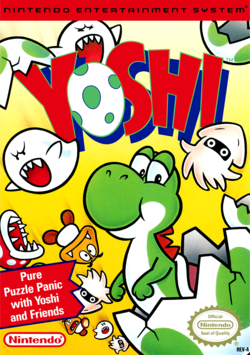 NES box art  Game Boy box art For alternate box art, see the game's gallery. | |||||||||||||||
| Developer | Game Freak | ||||||||||||||
| Publisher | Nintendo | ||||||||||||||
| Platform(s) | Family Computer, Nintendo Entertainment System, Game Boy, Virtual Console (Wii, 3DS, Wii U), Nintendo Entertainment System - Nintendo Switch Online | ||||||||||||||
| Release date | Famicom/NES: Game Boy: Virtual Console (Wii): Virtual Console (3DS) (Ambassador Program Release): Virtual Console (3DS) (Full Release): Virtual Console (Wii U): Nintendo Entertainment System - Nintendo Switch Online: | ||||||||||||||
| Language(s) | English (United States) Japanese | ||||||||||||||
| Genre | Puzzle | ||||||||||||||
| Rating(s) |
| ||||||||||||||
| Mode(s) | 1-2 players in a same system | ||||||||||||||
| Format | Famicom:
NES:
Wii: Wii U: Nintendo Switch: Game Boy:
Nintendo 3DS: | ||||||||||||||
| Input | Famicom:
NES:
Wii: Wii U: Nintendo Switch: Game Boy:
Nintendo 3DS:
| ||||||||||||||
| Serial code(s) | Famicom/NES: Game Boy: | ||||||||||||||
Yoshi (known in Japan as Yoshi no Tamago (ヨッシーのたまご, lit. "Yoshi's Egg") and as Mario & Yoshi in other non-American regions) is a puzzle game for the Family Computer/NES and Game Boy featuring the titular character. In this game, the player must stack two of the same Super Mario enemy on top of one another to clear them. The concept of the game was inspired by Tetris.
The NES version of this game was later released on the Virtual Console for the Wii in 2007, the Nintendo 3DS in 2011-2012, and the Wii U in 2013. It was also made available as one of the 20 NES titles at the Nintendo Switch Online's service launch in September 2018.
A sequel or remake, titled Super Yoshi no Tamago, was in development for the Super Famicom in 1995, but it was canceled. It was ported to the Nintendo DS in 2007 as a tech demo during the development of Pokémon Black Version and Pokémon White Version.[10]
Game modes[edit]
1-Player Mode[edit]
In this mode, only one player who controls Mario plays the game. There are two "types" of game to play, the A Type, and B Type. Before each game, the player sets the type of game, level of difficulty, speed of falling enemies, and in-game music for the game ahead. A board is made out of four "plates" which enemies fall onto. Mario uses left and right on the D-Pad to move about, and the (
![]() on Wii Virtual Console) and
on Wii Virtual Console) and (
![]() on Wii Virtual Console) Buttons to make two plates switch places. In the NES version, each plate can hold up to 8 characters, while in the Game Boy version, the max is 7.
on Wii Virtual Console) Buttons to make two plates switch places. In the NES version, each plate can hold up to 8 characters, while in the Game Boy version, the max is 7.
Mario must match the enemy icons to earn points and, hopefully, make a high score. Any two enemies placed together vertically make a match, earning Mario five points. A very handy way of clearing excess enemies from the board are egg halves. There are two halves that stack together to make a full egg, thus hatching a Little Yoshi and getting fifty points for Mario. When a top half is placed by itself on the board, it will dissipate. But if a bottom piece is placed, there it will stay until another falls on top of it for an ordinary match, or a top piece stacks onto it.
A handy little tip is that no matter how many enemies are on top of the bottom egg piece, if the top piece is placed on the same stack as the bottom, it will plow through the entire stack until it reaches its other half. This is also a big point boost, as any enemy inside the stack equals fifty points. It will also result in a larger Yoshi hatching from the egg. The levels of Yoshis are as follows:
| Yoshi | Enemies (NES) | Enemies (GB) | Points |
|---|---|---|---|
Little Yoshi |
0-1 | 0 | 50 |
Yoshi |
2-4 | 1-3 | 100 |
Winged Yoshi |
5-6 | 4-5 | 200 |
Star Yoshi |
7 | 6 | 500 |
A Type[edit]
As the game progresses, more and more enemies come down, faster and faster. The game never ends, though. The only point is to make a high score. If the player has hatched at least 10 Yoshi's eggs before Game Over, a bonus chance will occur. Four eggs will appear on screen and hatch in succession. The player must press the A button as the eggs hatch, for a chance to earn some extra points. The better timed the press is, the better the Yoshi that is awarded. Besides Yoshi, the content in the eggs will change depending on how many were hatched before the game ended. If 100 eggs are hatched, Yoshi will continously dance under the egg counter, and upon reaching Game Over, the game will congratulate the player as a "super player".
| Eggs | Item (NES) | Item (GB) |
|---|---|---|
| 10 | Little Goomba |
Mushroom |
| 20 | Piranha Plant |
Fire Flower |
| 30 | Boo Buddy |
Super Star |
| 40 | Bloober |
Boo Buddy |
| 50 | Bob-omb | |
| 60 | Cheep Cheep |
Bob-omb |
| 70+ | Super Star |
Cheep Cheep |
B Type[edit]
Exactly like the A Type, but now games are timed. When the board is completed, both the score and the amount of time spent on that game are recorded. Between levels, a short cutscene will play. Mario will ride Yoshi from the background to the foreground where he swallows an enemy or item, awarding bonus points.
| Level | Reward | Bonus Points |
|---|---|---|
| 1 | Mushroom |
50 |
| 2 | Fire Flower |
100 |
| 3 | Piranha Plant |
150 |
| 4 | Red Shell |
200 |
| 5 | Super Star |
250 |
| 6-7 | Apple |
300 |
| 8-9 | Strawberry |
400 |
| 10-11 | Melon |
500 |
| 12-13 | Peach |
600 |
| 14-15 | Grapes |
700 |
| 16-18 | Pineapple |
800 |
| 19-21 | Cherry |
900 |
| 22-24 | Key |
1000 |
| 25-27 | Coin |
1200 |
| 28+ | P Switch |
1500 |
2-Player Mode[edit]
Before a player face-off, each one picks their own level and speed. The game is played with B Type rules. On the NES, the board is now split in half, left half for Player 1, Mario, right half for Player 2, Luigi. On the Game Boy, a counter is present comparing the number of enemies left on screen for both players. Enemies that become sandwiched between two egg shells will be sent to the other player's side as garbage blocks. If a player loses, they gain an "X", while the winning player (whoever was still alive when his opponent lost) gains an "O". An "X" simply signifies a lost game, and "O", one won. Won games are recorded on the upper part of each player board by Yoshi's eggs. If a player has three eggs, they win.
Characters[edit]
- Mario (Playable)
- Luigi (Playable)
- Yoshi
- Little Yoshi
- Little Goomba
- Bloober
- Boo Buddy
- Piranha Plant
Appearances in other media[edit]
Yoshi was the subject of the Yoshi no Tamago volume of the Super Mario manga serie by KC Deluxe, written and drawn by Kazuki Motoyama.
It has two different stories. The first story involves Yoshi opening a restaurant called Yossy's Pizza (note that the Yossy in the name was how Yoshi's name was anglicized in Japan at the time), and the second story (divided into three separate parts) involves Yoshi, Mario, Luigi, and Peach embarking on a journey to find his mother.
Reception[edit]
Yoshi received mixed to negative reviews for its repetitive and luck-based gameplay. Brett Alan Weiss of Allgame said that Yoshi was a "surprisingly dull game" and he noted that the controls were unique, but he also added; "the novelty wears off after a while."
N-Force gave the game a positive review saying that in a preview for the game that it was "basically the game is great. The fun of Tetris, but with color and sound effects. Just as hard, maybe harder - definitely just as addictive." They later rated the game 4/5 stars in the Buyer's Guide for the Jan. 1993 issue saying that "Yoshi is great fun. Gameplay's nothing new - Tetris all over again! Graphics are a treat. Lots of fun - in short bursts."
Despite the negative reviews, the game sold well and helped Game Freak create the first Pokémon games.
The Virtual Console re-release also received negative reviews. GameSpot's Frank Provo and IGN's Lucas M. Thomas both gave the game 5 of 10 stars, with Thomas commenting the game's "slow" gameplay and the "cumbersome" controls.
Several video game websites said that players should refrain from buying Yoshi on the Wii Shop Channel. Nintendo World Report said; "There was too much luck and chance in the game to make playing it satisfying." Joystiq said; "While [the gameplay is] admittedly a pretty interesting way to spend an afternoon, it still feels kind of a ripoff."
1UP.com's Jeremy Parish stated that the gameplay was "not enough to justify the asking price" (500 points), but he later stated that, compared to Yoshi's Cookie, it was "decent and actually had some relationship to the Mario series."
References to other games[edit]
- Super Mario Bros. 3: Mario's sprite from this game appears on the high score board. All of the enemies look identical to their sprites from Super Mario Bros. 3 (with the exception of Piranha Plants and Boos)
- Super Mario World: Yoshi's many forms and the Piranha Plants' design are from this game.
References in later games[edit]
- Pokémon Red and Blue: A portion of the Star theme sounds identical to the first few notes of the Pokémon Center theme used in that game. This is evidenced in the Game Boy version.
- Super Mario Bros. Deluxe: The image that appears when Yoshi is brought to Toad after hatching him is similar to the image in the title screen of the NES version.
- Super Smash Bros. for Wii U: A demo of the game under "Masterpieces" can be played after beating Classic Mode with Yoshi in Intensity 2.0 or higher.
Pre-release and unused content[edit]
An unused title screen graphic (pictured at the left) depicting a Little Yoshi is found in the game files. In the Game Boy version, an unused Bullet Bill can also be found (pictured at the right).
Gallery[edit]
- For this subject's image gallery, see Gallery:Yoshi (game).
Names in other languages[edit]
| Language | Name | Meaning | Notes |
|---|---|---|---|
| Japanese | ヨッシーのたまご[?] Yosshī no Tamago |
Yoshi's Egg | |
| Dutch | Mario en Yoshi[?] | Mario and Yoshi | |
| French | Mario et Yoshi[?] | Mario and Yoshi | |
| German | Mario und Yoshi[?] | Mario and Yoshi | |
| Italian | Mario & Yoshi[?] | - | |
| Korean | 요시의 알[?] Yosi ui al |
Yoshi's Egg | |
| Portuguese | Mario e Yoshi[?] | Mario and Yoshi | |
| Russian | Марио и Йоши[?] Mario i Yoshi |
Mario and Yoshi | |
| Spanish (NOA) | Yoshi[?] | - | |
| Spanish (NOE) | Mario & Yoshi[?] | Mario and Yoshi |
Notes[edit]
- In the English-language text of Super Smash Bros. for Wii U, the Masterpieces erroneously states that the game was released on May 28, 1992.
References[edit]
- ^ ヨッシーのたまご | ファミリーコンピュータ | 任天堂. Nintendo Co., Ltd. (Japanese). Retrieved January 13, 2025.
- ^ a b Super Smash Bros. Brawl Chronicle
- ^ Nintendo NES Games release chart (PDF). Nintendo.com. Archived September 21, 2008, 01:55:24 UTC from the original via Wayback Machine. Retrieved June 1, 2024.
- ^ Yoshi (NES). The Mushroom Kingdom (English). Retrieved June 1, 2024.[better source needed]
- ^ ヨッシーのたまご. Nintendo Co., Ltd. (Japanese). Retrieved January 13, 2025.
- ^ Nintendo Game Boy (original) Games release chart (PDF). Nintendo.com. Archived October 3, 2008, 18:12:32 UTC from the original via Wayback Machine.
- ^ Yoshi (GB). The Mushroom Kingdom (English). Retrieved June 1, 2024.
- ^ Mario & Yoshi. Nintendo of UK (British English). Retrieved June 1, 2024.
- ^ Wii. Nintendo of Korea (Korean). Archived December 5, 2008, 12:09:42 UTC from the original via Wayback Machine. Retrieved June 1, 2024.
- ^ Welsh, O. (October 14, 2024). Pokémon developer Game Freak suffers massive data leak. Polygon. Retrieved October 14, 2024.
| Yoshi | ||
|---|---|---|
| Characters | Mario • Yoshi • Luigi | |
| Enemies | Puzzle pieces | Bloober • Boo Buddy • Little Goomba • Piranha Plant |
| Other | Bob-omb • Cheep Cheep | |
| Yoshi types | Little Yoshi • Yoshi • Winged Yoshi • Star Yoshi | |
| Items | Apple • Cherry • Coin • Fire Flower • Grape • Key • Melon • P Switch • Pineapple • Peach • Red Shell • Strawberry • Super Mushroom • Super Star • Yoshi's egg | |
| Miscellaneous | Gallery | |
| Game Boy games | |
|---|---|
| Super Mario franchise | Alleyway (1989) • Baseball (1989) • Super Mario Land (1989) • Golf (1989) • Dr. Mario (1990) • Super Mario Land 2: 6 Golden Coins (1992) • Donkey Kong (1994) • Mario's Picross (1995) • Picross 2 (1996) |
| Donkey Kong franchise | Donkey Kong (1994) • Donkey Kong Land (1995) • Donkey Kong Land 2 (1996) • Donkey Kong Land III (1997) |
| Yoshi franchise | Yoshi (1991) • Yoshi's Cookie (1992) • Tetris Attack (1996) |
| Wario franchise | Wario Land: Super Mario Land 3 (1994) • Wario Blast: Featuring Bomberman! (1994) • Wario Land II (1998) |
| Miscellaneous | Tetris (1989) • The Legend of Zelda: Link's Awakening (1993) • Game & Watch Gallery (1997) • Game & Watch Gallery 2 (1997) • Game Boy Camera (1998) |
